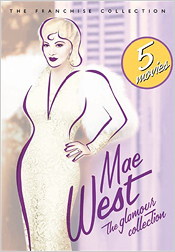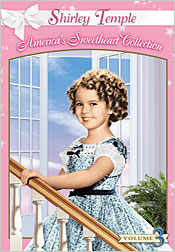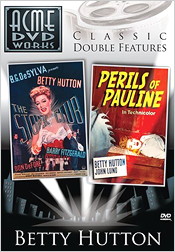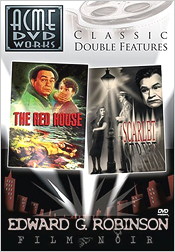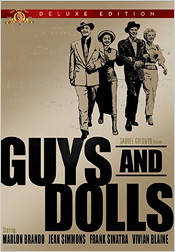 |
Site created 12/15/97.

page created: 5/17/06
 Barrie Maxwell - Main Page |
||
| Classic
Reviews Round-Up #27 and New Announcements In this edition of the column, I cover seven recent releases encompassing 14 feature films and one TV series, as well as presenting the usual new announcements. Included in the new reviews are: Mae West: The Glamour Collection from Universal; Shirley Temple: America's Sweetheart Collection, Volume 3 and The Story of Ruth from Fox; a Betty Hutton Double Feature and an Edward G. Robinson Double Feature from VCI; the Guys and Dolls Deluxe Edition from Sony; and Sgt. Bilko: The Phil Silvers Show 50th Anniversary Edition from Paramount. As usual, the reviews are presented according to the year of original release. For those wondering what future columns will bring, I hope to catch up with a number Warner releases from the past four months in one column and do a western review round-up including May's releases in another column. I will also be experimenting with the review format in future months as I try to reduce review comments so that I can provide coverage of more titles. Your thoughts on the proper balance are welcome. In the meantime, let's get to this outing's new reviews. Reviews |
||
| Mae
West's first starring vehicle was She
Done Him Wrong followed quickly thereafter by I'm
No Angel, both released in 1933 by Paramount. These were
the two finest films of West's career because the plots were
interesting in themselves, but more importantly, her stories and
dialogue were unfettered by the Production Code, allowing the
sauciness and innuendo that her stage work was famous for to be
freely translated to the screen. With her fourth film, 1934's Belle
of the Nineties, Hays Office interference was
increasingly an issue, but Mae West was a huge star by then and the
film was also a substantial star vehicle for her concentrating more
on accentuating her talents than presenting a story with good
continuity. Film Rating (I'm No Angel): A Disc Ratings (Video/Audio/Extras): A-/B+/C- 1935's Goin' to Town continued the trend with further reduction of suggestive elements but increased focus on Mae as the centre of attraction. The rags-to-riches plot line was one that was more developed than that in the previous film and it represented Mae's first foray into a western of sorts, with the overall result being very entertaining. Klondike Annie, made in 1936, had a less happy result as the film had some significant portions deleted from it by Paramount who feared box office losses. What remained was still top-notch Mae West, but it was also her last film to really attempt to take on the censors. Film Rating (Goin' to Town): A- Disc Ratings (Video/Audio/Extras): B+/B+/D Go West Young Man (1936) seemed to focus more on situational comedy than the comedic dialogue which had been West's forte and the result was not positive, as much of the film seems tedious rather than funny. Every Day's a Holiday (1938) was Mae West's last film for Paramount. It was an unengaging affair that found Mae still trying but frequently failing to succeed with much of the same sort of material that had proved effective just two or three years previously. It was the first Mae West film not to make a profit. Mae's contract with Paramount was up for renewal, but Paramount refused her demand to make a colour film based on a Catherine the Great story idea, so the two sides parted company. Film Rating (Go West Young Man): B- Disc Ratings (Video/Audio/Extras): B+/B-/D Universal gave her an opportunity in 1940 to appear with W.C. Fields in My Little Chickadee, but the film turned out to be Fields' with Mae's work little more than an afterthought. There was little real magic in any of West's and Fields' scenes together. Ironically, the film is probably the one most seen by people of succeeding generations of any in her career. Mae had an option appear in two more Fields films for Universal, but she turned it down and her career wound down accordingly. Film Rating (My Little Chickadee): B+ Disc Ratings (Video/Audio/Extras): A-/B+/C- In Mae West: The Glamour Collection, Universal gives us a nice sampling of five of the nine films from the core of Mae West's career. All are presented full frame as originally projected and all are typically good-looking Universal DVD transfers for films of this period. The images are generally sharp with fine detail and modest grain that imparts a nice film-like look. The first two and the last of the collection are the best looking while Goin' to Town and Go West Young Man are a little softer-looking and somewhat more prone to vertical scratches and speckles. The mono sound on all is more than adequate. There is some background hiss, but it's only really intrusive to any significant extent on Go West Young Man. English, Spanish, and French sub-titles are included. The only extras are trailers for Night After Night, I'm No Angel, and My Little Chickadee. On the whole the set is on a par quality-wise with the Carole Lombard collection that came out at the same time. The format is similar to other Universal collections with multiple films presented on only one or two discs. In this instance, the first three films are contained on a two-sided disc and the other two films contained on one side of a single-sided disc. I experienced no skipping or lock-up problems with the Mae West discs. Recommended. |
||
|
||
| Film
Rating (Dimples): B- Disc Ratings (Video/Audio/Extras): C/B-/C The Little Colonel co-stars Lionel Barrymore and Bill "Bojangles" Robinson and in the years after the Civil War, finds Shirley attempting to reconcile her mother with her grandfather who had earlier disowned his daughter when she ran off and married a northerner. The musical highlights team Shirley with Robinson, particularly in one of Robinson's patented staircase tap-dancing routines. The film is in black and white except for a brief Technicolor sequence at the end. It's quite amusing to see the colourized version of this sequence and note how poorly it manages to replicate the real thing. The image is substantially better than that for Dimples with good shadow detail and only a modest amount of grain. Film Rating (The Little Colonel): B- Disc Ratings (Video/Audio/Extras): B-/B-/C The Littlest Rebel finds Shirley living on a southern plantation when the Civil War breaks out. Her father goes off to war but when her mother's health begins to fail, one of the family's slaves (Bill Robinson) tries to find him and bring him home before his wife dies. In a scene that could only happen in a Shirley Temple film, she and Robinson have to travel to Washington to see President Lincoln in order to save her father from being executed as a spy. This is the best of the three films in this volume with an endearing story, a particularly strong cast (John Boles, Karen Morley, Jack Holt, and Guin "Big Boy" Williams), and fine musical numbers again featuring Rill Robinson. Fittingly, the transfer is also marginally the best of the bunch too, being quite sharp and well detailed with not too much debris in evidence. Film Rating (The Littlest Rebel): A- Disc Ratings (Video/Audio/Extras): B+/B-/C The sound on all three films is workable, with modest background hiss sometimes present. Both Stereo and mono options are offered as are English and Spanish sub-titles. The supplements are confined to some theatrical trailers and Fox Movietone newsreel footage. Recommended for Shirley Temple fans, otherwise a rental. |
||
| The
Stork Club finds Betty playing hat-check girl Judy
Peabody at, where else, the Stork Club in New York. She saves the
life of millionaire Jerry Bates (Barry Fitzgerald) when he almost
drowns while despondent over his failing marriage. Gratefully, Bates
sets Judy up financially for life, but the money gets in the way of
both Judy's love life and her budding singing career. Hutton tries
hard to give the film some pizzazz, but it lacks in originality and
in sufficiently effective musical/comedy talent despite the presence
of Robert Benchley and Barry Fitzgerald's querulous efforts. While
efforts were made to make the set resemble the actual Stork Club,
there's not enough magic to that location to give the film any
substantial boost. The film was shot in black and white and VCI's
transfer is merely workable - a little ragged-looking with
noticeable scratches and speckles and an image that varies from too
dark to too light. Film Rating (The Stork Club): B Disc Ratings (Video/Audio/Extras): B-/B-/C- Perils of Pauline is the typically Hollywoodized version of the truth, in this case that of how silent serial Pearl White rose to stardom. The film is such an out-and-out star vehicle for Hutton that one never has the slightest feeling that there's any resemblance to the actual Pearl White story, despite the brief appearances of a number of silent players such as William Farnum, Chester Conklin, James Finlayson, and Snub Pollard. Aside from all that, however, the film is an entertaining pastime with an energetic performance by Hutton and some good support from familiar faces such as William Demarest, Billy De Wolfe, and Frank Faylen. The Technicolor film is merely passable-looking in this VCI release, lacking the vibrancy and accurate colour of proper restorations. The colour looks smeared at times and is generally soft with an orangey tendency to its cast. Film Rating (Perils of Pauline): B Disc Ratings (Video/Audio/Extras): B-/B-/C- VCI has also included the theatrical trailer for The Stork Club and the colour Noveltoon Naughty But Mice. For the modest price, the disc is a not unreasonable purchase if you want these two Betty Hutton films. For those with a special interest in only Perils of Pauline, a previous stand-alone release by Roan Group is a better choice because of its slightly darker and sharper image. |
||
| Film
Rating (Scarlet Street): A- Disc Ratings (Video/Audio/Extras): C/C/C- Film Rating (The Red House): B+ Disc Ratings (Video/Audio/Extras): C-/C-/C- Is there any particular reason to pick up this latest presentation of the two films? Well, not really. The price of $5 list is right, but lots of the other versions available are equally reasonable in price. The image quality offers no particular advantage over other offerings either. Both films are watchable, but subject to comparable issues such as excessive speckling and scratches on The Red House and a rather dark image on Scarlet Street. The sound on both is also okay, although background hiss is certainly in evidence. VCI adds a 1947 Movietone newsreel as an extra. If you're really interested in the best version of Scarlet Street, seek out Kino's recent DVD release sporting a restored transfer and an audio commentary. If it's The Red House that you're most interested in, this VCI release is as good a choice as any I've seen. |
||
| Current
hot commodity Joseph L. Mankiewicz was engaged to direct even though
he'd never done a musical. That shortcoming was compensated for by
having Michael Kidd restage all his original stage choreography for
the film. Jean Simmons was brought on board to play Sarah after
Goldwyn struck out in his efforts to get Grace Kelly and Deborah
Kerr for the part. Fortunately too, the unavailability of Betty
Grable to play Adelaide lead to the decision to engage Vivian Blaine
who had made the role her own on stage. Stubby Kaye from the stage
version was also a welcome addition to the cast. In bringing Guys and Dolls to the screen, Joseph Mankiewicz made some modifications to the story as staged on Broadway, including strengthening the Nathan Detroit part so that the story now had two equal romances (crap-game promoter Nathan Detroit and his long-suffering girlfriend Miss Adelaide, and bet-on-anything Sky Masterson and Sarah Brown of the Save-A-Soul Mission). The saga that eventually leads to both couples walking down the proverbial aisle together is dazzlingly presented in CinemaScope and Eastman Color, with stylized New York sets, energetic and exciting choreography, and a general feeling of warmth more than compensating for a protracted film length that flags somewhat at the mid-point. Sinatra, Blaine, and Kaye are delightful and usually bland Jean Simmons surprises in the Havana café scenes. Even Brando manages to overcome his questionable casting by infusing enough feeling into his songs to compensate for the fact that he couldn't sing. Still, to have Frank Sinatra in a film and not have him sing "Luck Be a Lady", but instead Brando, seems surreal somehow. Sony 's revisited presentation (a single disc, designated a Deluxe Edition) is a distinct improvement over the original MGM DVD release. The film is 149 minutes long and combined with an hour of supplements, that pushes the envelop for a single disc. It doesn't seem to have compromised the film presentation significantly, but I can't help but think that a two-disc presentation would have given the film room to look the absolute best it could be. That said, remastered in high definition, the 2.55:1 anamorphic transfer looks very good, offering bright, beautiful colour fidelity and depth. A few scenes seem a little soft, but for the most part the image looks sharp and clear with only minor, occasional edge effects. Both a new Dolby Digital 5.1 and a 3.0 track are offered. The former provides little audible enhancement over the latter, which is fairly lush in itself with modest directionality. The musical numbers fair well. A French mono and Spanish 5.1 track are also provided as are English, French, and Spanish subtitles. The supplements that Sony has provided are based on new interviews with Goldwyn biographer A. Scott Berg, choreographer Michael Kidd, Samuel Goldwyn Jr., Tom Mankiewicz, and composer/lyricist Frank Loesser's widow, daughter and son. The material has been divided into two documentaries of about 25 and 27 minutes plus about 8 minutes of extra interview material accessible separately. All told, this hour of supplements is interesting and even insightful at times, providing an enjoyable background to the film. Also included on the disc is an extensive photo gallery of in excess of 100 images. The other supplement is a nice 72-page booklet reproducing much of the film's original promotional material. Recommended. |
On to Part Two
Barrie Maxwell - Main Page
 |
| Site
designed for 1024 x 768 resolution, using 16M colors and .gif 89a
animation. © 1997-2015 The Digital Bits, Inc., All Rights Reserved. billhunt@thedigitalbits.com |
